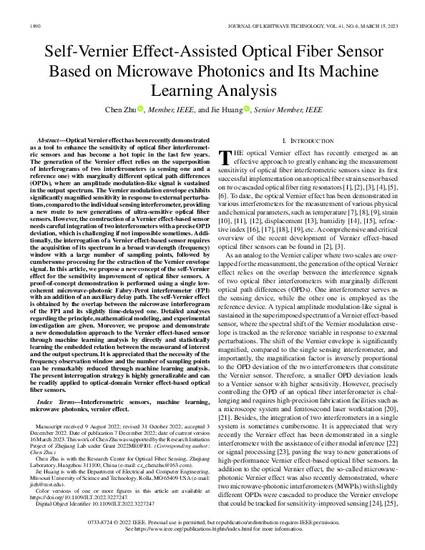
Optical Vernier Effect Has Been Recently Demonstrated as a Tool to Enhance the Sensitivity of Optical Fiber Interferometric Sensors and Has Become a Hot Topic in the Last Few Years. the Generation of the Vernier Effect Relies on the Superposition of Interferograms of Two Interferometers (A Sensing One and a Reference One) with Marginally Different Optical Path Differences (OPDs), Where an Amplitude Modulation-Like Signal is Sustained in the Output Spectrum. the Vernier Modulation Envelope Exhibits Significantly Magnified Sensitivity in Response to External Perturbations, compared to the Individual Sensing Interferometer, Providing a New Route to New Generations of Ultra-Sensitive Optical Fiber Sensors. However, the Construction of a Vernier Effect-Based Sensor Needs Careful Integration of Two Interferometers with a Precise OPD Deviation, which is Challenging If Not Impossible Sometimes. Additionally, the Interrogation of a Vernier Effect-Based Sensor Requires the Acquisition of its Spectrum in a Broad Wavelength (Frequency) Window with a Large Number of Sampling Points, Followed by Cumbersome Processing for the Extraction of the Vernier Envelope Signal. in This Paper, We Propose a New Concept of the Self-Vernier Effect for the Sensitivity Improvement of Optical Fiber Sensors. a Proof-Of-Concept Demonstration is Performed using a Single Low-Coherent Microwave-Photonic Fabry-Perot Interferometer (FPI) with an Addition of an Auxiliary Delay Path. the Self-Vernier Effect is Obtained by the overlap between the Microwave Interferogram of the FPI and its Slightly Time-Delayed One. Detailed Analyses Regarding the Principle, Mathematical Modeling, and Experimental Investigation Are Given. Moreover, We Propose and Demonstrate a New Demodulation Approach to the Vernier Effect-Based Sensor through Machine Learning Analysis by Directly and Statistically Learning the Embedded Relation between the Measurand of Interest and the Output Spectrum. It is Appreciated that the Necessity of the Frequency Observation Window and the Number of Sampling Points Can Be Remarkably Reduced through Machine Learning Analysis. the Present Interrogation Strategy is Highly Generalizable and Can Be Readily Applied to Optical-Domain Vernier Effect-Based Optical Fiber Sensors.
- Interferometers,
- interferometric sensors,
- machine learning,
- Microwave amplifiers,
- microwave photonics,
- Microwave photonics,
- Optical fiber sensors,
- Optical fibers,
- Optical interferometry,
- Sensors,
- Vernier effect
Available at: http://works.bepress.com/chen-zhu/88/